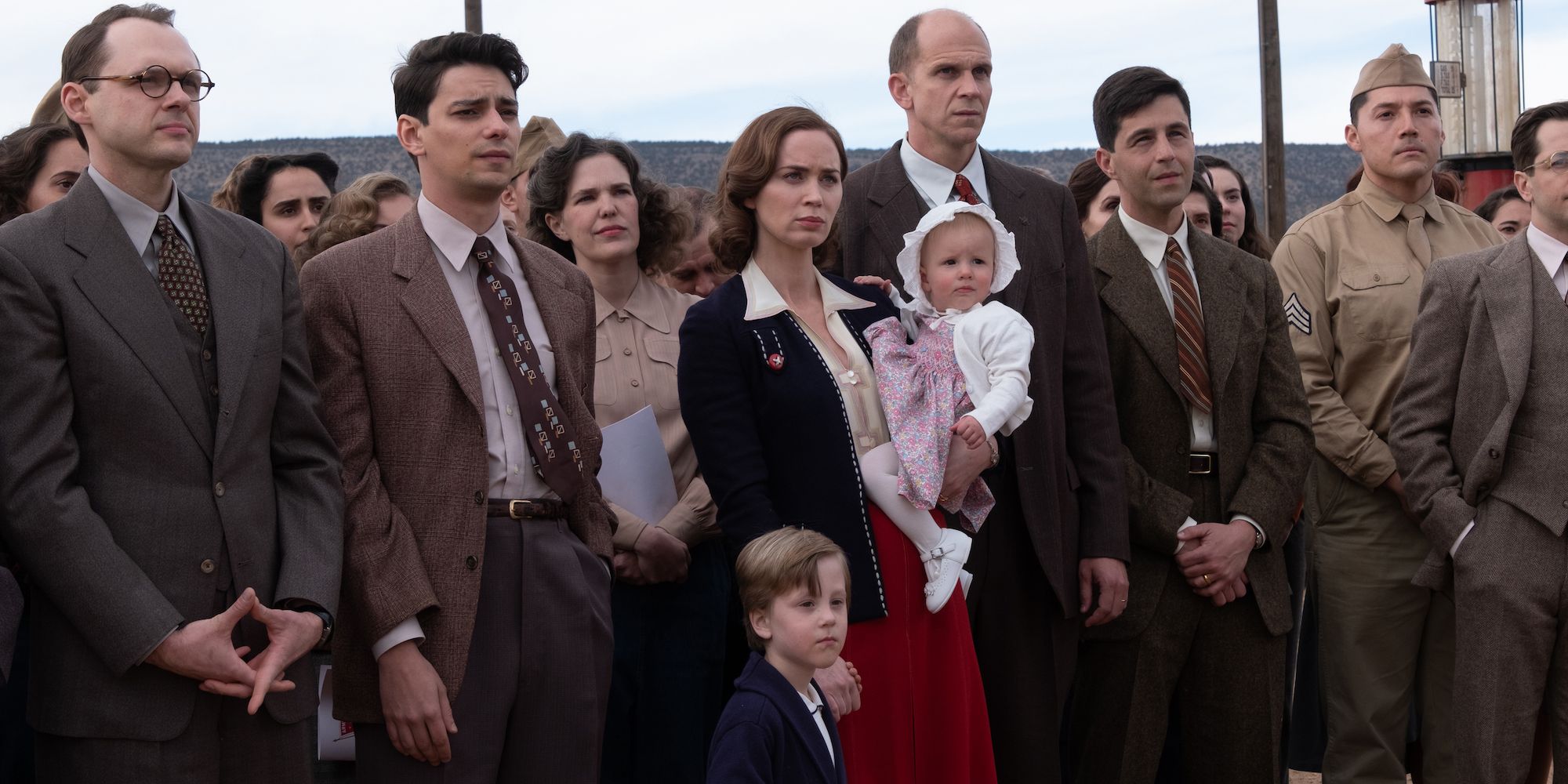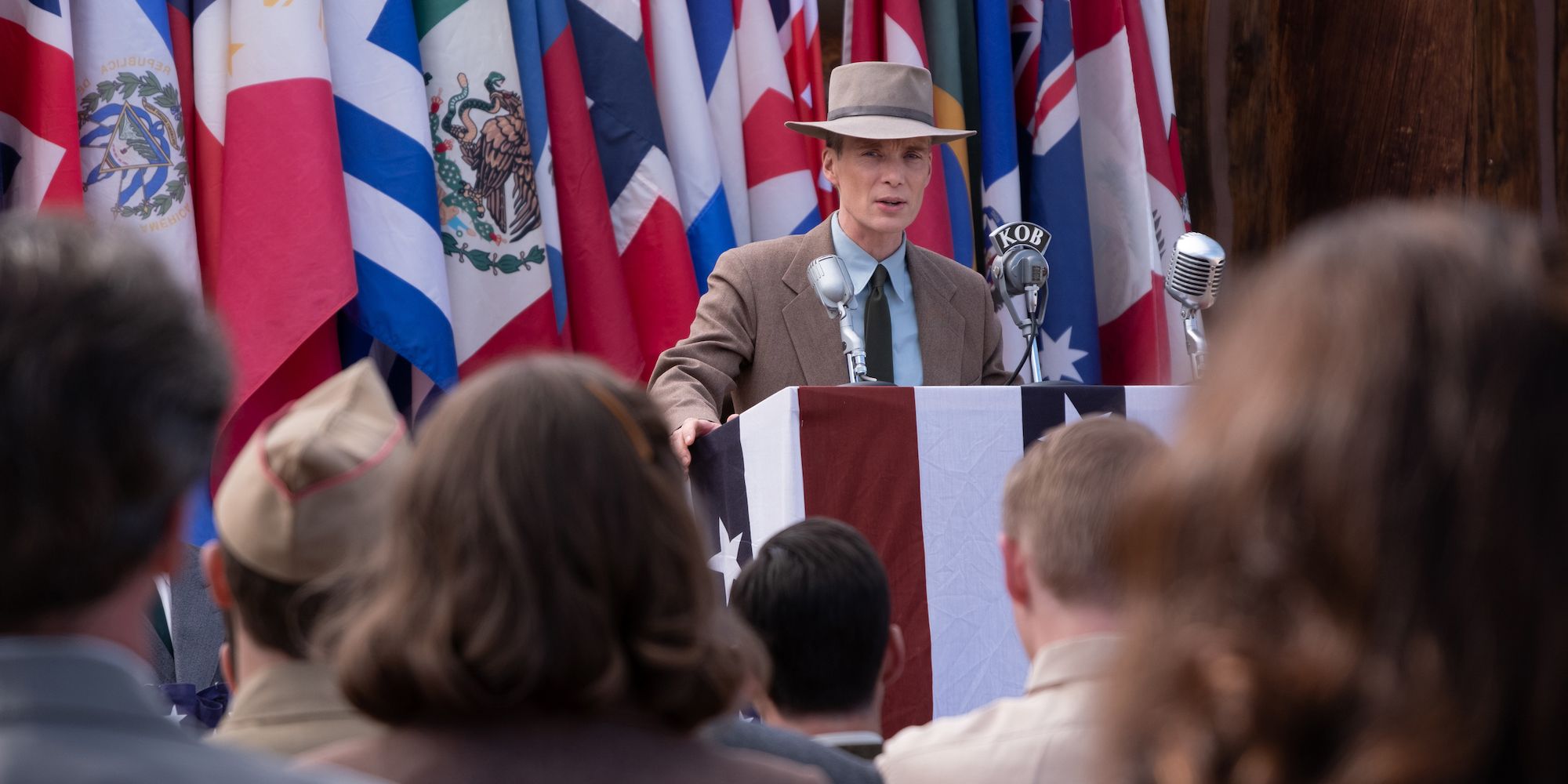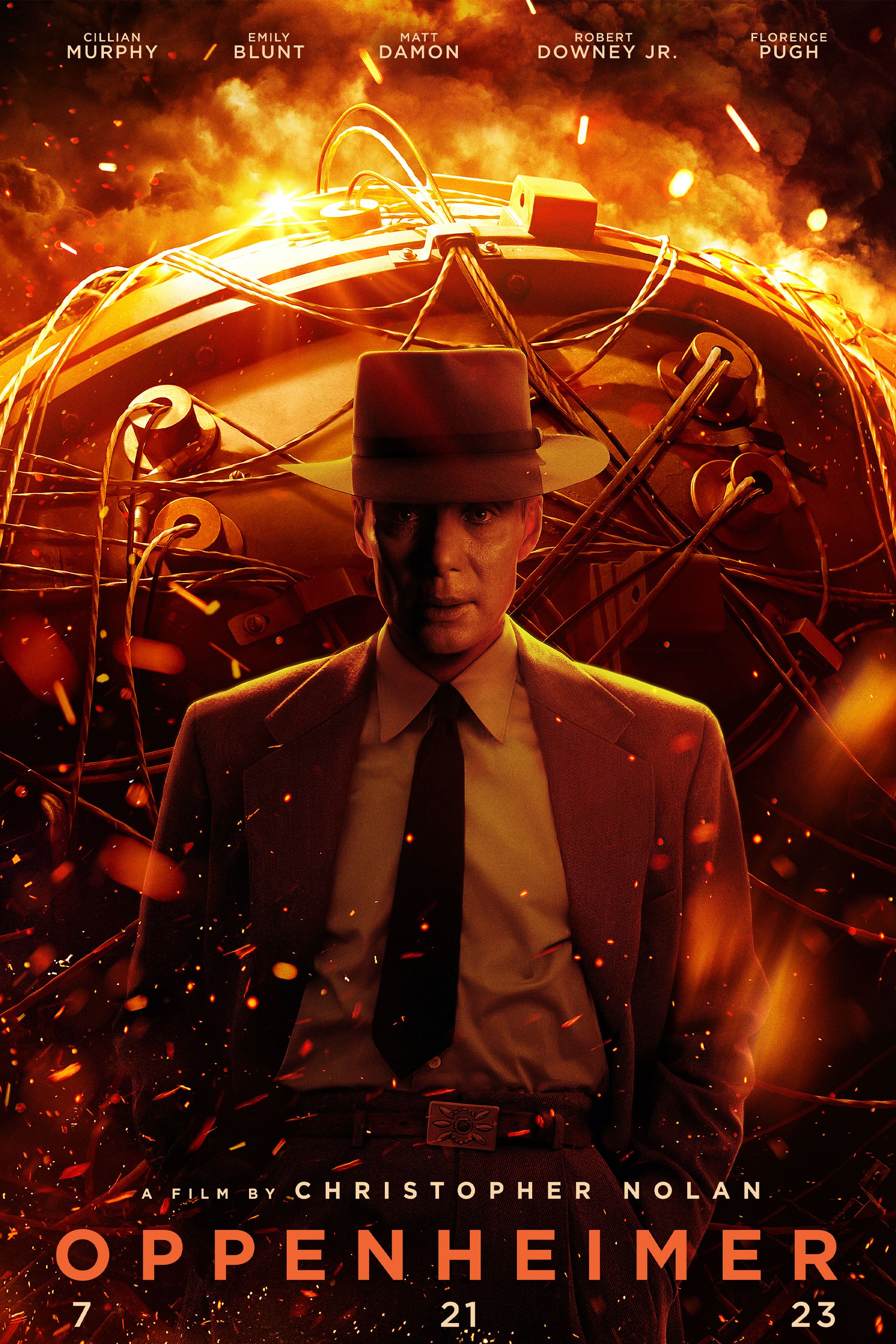Warning: This post contains spoilers for Oppenheimer
Written and directed by Christopher Nolan, Oppenheimer includes several details from J. Robert Oppenheimer’s life, many of which are true and some of them changed to benefit the film. Starring Cillian Murphy in the title role, the film spans decades of Oppenheimer’s life, from his days in Cambridge to heading the Manhattan Project in Los Alamos during World War II. The film is based on American Prometheus, the 2005 biography of Oppenheimer’s life by Kai Bird and Martin J. Sherwin.
Oppenheimer is considered the Father of the Atomic Bomb, and Nolan’s film is heavily focused on his work with the Manhattan Project, which resulted in the aforementioned bomb that would be detonated over Hiroshima and Nagasaki in Japan. But Oppenheimer also wades into other aspects of his life, including his affair with Jean Tatlock, the hearings that revoked his security clearance, and Lewis Strauss’ vendetta against the famed physicist. When it comes to making such biopics, filmmakers take creative liberties with the subject’s life. Oppenheimer‘s ending mostly sticks to the facts while leaving out — and adding — other aspects of the scientist’s life and the events that shaped it.
9 Oppenheimer Did Try To Poison His Tutor’s Apple
Niels Bohr Was Not Present However

Near the start of Oppenheimer, the young scientist moves to Europe to study physics. After being told by his mentor, Patrick Blackett, that he cannot attend a lecture by Kenneth Branagh’s Niels Bohr, Oppenheimer injects Blackett’s apple with cyanide. This incident is actually true; Oppenheimer did try to poison Blackett, though it’s unclear which chemicals he decided to use to do it. Oppenheimer’s attempts nearly got him expelled from Cambridge, but the scientist’s parents prevented that from happening.
In the film, Oppenheimer changes his mind about the poisoning, but when he shows up to the lab to retrieve the apple, it isn’t Blackett who’s holding it, but Bohr. Oppenheimer flings the apple away before he can take a bite, which would have led to catastrophe. But while Oppenheimer’s attempted poison did happen, Bohr was not involved in the incident, and there’s no record of the Danish physicist nearly eating the apple. This is likely added to Oppenheimer to flesh out Oppenheimer and Bohr’s relationship since the former was an admirer of the latter.
8 Oppenheimer Actually Bet Against The Atomic Bomb Working
The $10 Bet Really Happened
There were a lot of nerves at play on the day of the Trinity Test, and there were still apprehensions about whether the atomic bomb would destroy the atmosphere and annihilate the world with it. Oppenheimer made a bet that the atomic bomb wouldn’t actually work at all. Making light of the atomic bomb was very much something that Oppenheimer did. In fact, the physicist wagered $10 against fellow Manhattan Project scientist George Kistiakowsky’s monthly pay (via Office of History and Heritage Resources). Of course, the atomic bomb did work, and the Trinity Test was successful. It also did not ignite the atmosphere and destroy the world.
7 Oppenheimer Accepted Strauss’ Princeton Offer & Remained In The Position For 20 Years
Oppenheimer Skipped Over Their Partnership
A key figure in Oppenheimer is Lewis Strauss, who would become Oppenheimer’s enemy, offering the scientist the director position at Princeton’s Institute for Advanced Study. Oppenheimer tells Strauss that he’ll consider the offer, though it remains unclear whether he accepted it. As it turns out, Oppenheimer did take Strauss’ offer to head up the Institute for Advanced Study in 1947, two years after leaving Los Alamos behind. He would remain in the role for 20 years, long after his security hearings and Strauss being denied a cabinet position.
As director, Oppenheimer became Albert Einstein’s boss (Einstein himself had been with the IAS since 1932, via Princeton Alumni Weekly). During his tenure at Princeton, Oppenheimer’s relationship with Strauss became more strained, with tensions building further after Strauss became the head of the Atomic Energy Commission. The two butted heads, and Oppenheimer opposed Strauss’ on scientific issues, while the other came to suspect Oppenheimer was a communist spy. Regardless of the outcome of Oppenheimer’s hearing, he remained at the IAS until 1965.
6 General Groves Didn’t Know About Atomic Bomb’s Potential To Destroy The World
Groves Was In The Dark About The Weapon’s Power

Maj. Gen. Leslie Groves worked closely with Oppenheimer during the Manhattan Project years. In Oppenheimer, Groves is briefed on the possibility that the atomic bomb might destroy the world. While Oppenheimer assures him that the chance of that happening is “near zero,” Groves chuckles nervously, saying that he’d rather have that percentage actually be zero. But the truth was that Groves didn’t know about the atomic bomb’s potential for global destruction at the time. The conversation was largely kept between scientists, who were privy to Edward Teller’s calculations regarding the possibility of the atomic bomb wiping out the atmosphere.
5 Los Alamos Was Only 1 Of 3 Cities Created For The Manhattan Project
Cities In Tennessee And Washington Also Were Used

Oppenheimer focuses closely on Los Alamos, New Mexico, where much of the Manhattan Project’s work took place, because it was where Oppenheimer himself resided at the time. However, Groves actually approved two other locations — Oak Ridge, Tennessee and Hanford, Washington — for use under the Manhattan Project. Oak Ridge had a building where uranium was enriched, and the site held over 12,000 workers during its heyday. Meanwhile, the site at Hanford was where plutonium was produced. It was an ideal location due to the Columbia River, its waters used to cool the reactors. Los Alamos was largely utilized for atomic bomb design and development.
4 Oppenheimer Was Engaged To Jean Tatlock – Why She Really Ended Their Relationship
Jean Also Struggled With Being Queer

Oppenheimer highlights the scientist’s relationship with Jean Tatlock, a psychiatrist and communist who Oppenheimer met in 1936. Over the course of three years, the couple became engaged, but they had an on-again/off-again relationship for most of their time together. This is portrayed in Nolan’s film, but Jean’s struggle with her sexuality isn’t. Tatlock, who was clinically depressed, admitted to friends that she was attracted to women. It scared her because being queer at the time signified a condition that could be fixed. Her struggles played a role in the end of her relationship with Oppenheimer. They saw each other again in 1943 — the last time before Tatlock’s suicide.
3 Oppenheimer Didn’t Have A Concrete Opinion About The Atomic Bomb’s Creation & Use
The Movie Plays Up His Concern

Nolan underscores Oppenheimer’s noncommittal state. While he grew concerned with the use of nuclear power and its dangers to the world in the weapons race, Oppenheimer wasn’t strongly opposed to the atomic bomb’s creation or its use. Oppenheimer worried more about what such bombs could do to the world in the future but didn’t express an abundance of regret regarding its creation. He wasn’t a moral guide, and only saw things more clearly thereafter. Oppenheimer believed the atomic bomb was a necessary evil, but was indifferent to the government using his research. He pushed for the sharing of atomic knowledge but was less critical in the role he played.
2 J. Robert Oppenheimer’s “I Am Become Death” Line Did Not Happen Like The Movie
It Happened On TV In Real Life

One of the most controversial true story changes in the movie comes with Oppenheimer‘s use of the “I am become death” quote. The quote is heard twice during Nolan’s movie, but neither instance is an accurate representation of how J. Robert Oppenheimer used the Bhagavad Gita quote in real life. Oppenheimer is only ever recorded saying the line during a 1956 NBC News documentary called The Decision to Drop the Bomb. This is where he says, “Now I am become death, the destroyer of worlds.” Nolan’s movie includes the saying during an Oppenheimer and Jean Tatlock sex scene and after the atomic bomb test instead.
1 Oppenheimer’s Opposition To The Hydrogen Bomb Played A Crucial Role In His Hearing
It Wasn’t Just His Communist Connections

While the last third of Oppenheimer is focused on Oppenheimer and Strauss’ parallel hearings, a big reason why the scientist’s security clearance was ultimately revoked was due to his opposition to the hydrogen bomb. Truman was pushing the AEC to develop a hydrogen bomb, which was much stronger than the atomic bomb, but Oppenheimer resisted. Yes, Strauss also held a personal grudge against Oppenheimer, but it was the scientist’s vehemence against the creation of the hydrogen bomb that ruffled feathers. By the 1950s, Oppenheimer had already been under FBI surveillance for a while, and his opposition, paired with his ties with communist friends, turned officials against him.

Oppenheimer
- Release Date:
- 2023-07-21
- Director:
- Christopher Nolan
- Cast:
- Cillian Murphy, Emily Blunt, Matt Damon, Robert Downey Jr., Rami Malek, Florence Pugh
- Rating:
- R
- Runtime:
- 150 Minutes
- Genres:
- Drama, History, Biography
- Writers:
- Christopher Nolan
- Budget:
- $100 Million
- Studio(s):
- Syncopy Inc., Atlas Entertainment
- Distributor(s):
- Universal Pictures





